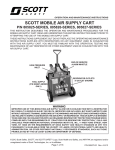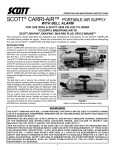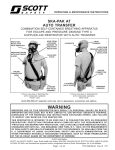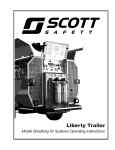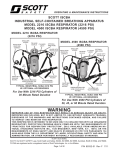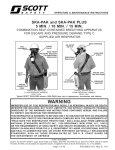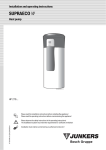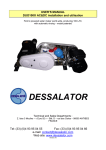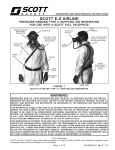Download SCOTT TRC-1 AIR CART
Transcript
OPERATION AND MAINTENANCE INSTRUCTIONS SCOTT TRC-1 AIR CART P/N 200070-SERIES THIS INSTRUCTION DESCRIBES THE OPERATION AND MAINTENANCE PROCEDURES FOR THE TRC-1 AIR CART. READ AND UNDERSTAND THIS ENTIRE INSTRUCTION SHEET PRIOR TO ATTEMPTING THE USE OF THIS TRC-1 AIR CART. THESE INSTRUCTIONS SUPPLEMENT, BUT DO NOT REPLACE THE OPERATING AND MAINTENANCE INSTRUCTIONS SUPPLIED WITH RESPIRATORS OR ANY EQUIPMENT USED IN CONJUNCTION WITH THIS AIR CART. YOU MUST BE FAMILIAR WITH THE OPERATION, TESTING AND MAINTENANCE OF ANY RESPIRATOR OR OTHER EQUIPMENT USED IN CONJUNCTION WITH THIS AIR CART. SEE WARNING BELOW. SCOTT TRC-1 AIR CART P/N 200070-SERIES WARNING IMPROPER USE OF THIS BREATHING AIR SUPPLY ALONE OR IN CONJUNCTION WITH A RESPIRATOR MAY RESULT IN SERIOUS INJURY OR DEATH. IMPROPER USE INCLUDES, BUT IS NOT LIMITED TO USE WITHOUT ADEQUATE TRAINING, DISREGARD OF THE WARNINGS AND INSTRUCTIONS CONTAINED HEREIN, AND FAILURE TO INSPECT AND MAINTAIN THE AIR SUPPLY OF RESPIRATOR. THIS AIR SUPPLY IS INTENDED TO BE USED ONLY IN CONJUNCTION WITH AN ORGANIZED RESPIRATORY PROTECTION PROGRAM WHICH COMPLIES WITH THE REQUIREMENTS OF “PRACTICES FOR RESPIRATORY PROTECTION,” Z.88.2-1992 AVAILABLE FROM AMERICAN NATIONAL STANDARDS INSTITUTE, INC., 11 WEST 42ND STREET, NEW YORK, NY 10036 OR THE REQUIREMENTS OF OSHA SAFETY AND HEALTH STANDARD 29 CFR 1910 PARAGRAPH 134 AVAILABLE FROM THE US DEPT. OF LABOR, OCCUPATIONAL SAFETY AND HEALTH ADMINISTRATION, OR OTHER PERTINENT NATIONALLY RECOGNIZED STANDARDS, SUCH AS THOSE PROMULGATED BY THE US COAST GUARD OR DEPARTMENT OF DEFENSE. © 2012 Scott Safety. SCOTT, the SCOTT SAFETY Logo, Scott Health and Safety, AIR-PAK, and TRC-1 are registered and/or unregistered marks of Scott Technologies, Inc. or its affiliates. P/N 595269-01 Rev. A 6/12 Page 1 of 20 GENERAL DESCRIPTION The SCOTT TRC-1 air cart can be used as a breathing air supply for respirators that have an operating pressure range that can be maintained by this unit, such as the SCOTT AIR-PAK 2.2, 4.5, or 5.5 respirator or Industrial SCBA equipped with extended duration hose line option, or Type C air line respirators when used with combination Type C/Escape respirators such as the SCOTT SKA-PAK respirator. The TRC-1 air cart is available in configurations as follows: • 200070-SERIES Four outlet breathing RESPIRATOR SUPPLY with a separate Four outlet AUXILIARY SUPPLY The TRC-1 air cart can be fitted with two cylinders filled with clean breathing air. The two cylinders may be either 2216 psi, 3000 psi, 4500 psi, 5500 psi, or any combination of these. The minimum NIOSH duration of any cylinder shall be thirty (30) minutes. All units are fitted with a high pressure inlet which permits connection of the TRC-1 air cart to a remote high pressure breathing air source for continuous service while saving the cylinders as reserve. In addition, a selector valve permits dedication of the remote high pressure air source to supplying the AUXILIARY SUPPLY while the cylinders are dedicated to the RESPIRATOR SUPPLY. The TRC-1 air cart consists of a wheeled frame unit containing the air supply cylinders with all controls. The cart handle extends to facilitate transport. Each cylinder supply connection has its own vent valve, allowing replacement of one cylinder while the other is in use. An inlet high pressure gauge on the high pressure manifold and low pressure gauges on the two low pressure manifolds indicate the pressure at each stage of the system. A low pressure warning alarm whistle indicates, along with the supply pressure gauge, when the cylinder supply breathing air source has dropped below a preset range of approximately 500 psi. A low pressure warning bell alarm indicates when the remote high pressure breathing air source has dropped below a preset range of approximately 500 psi. BREATHING AIR SUPPLY CYLINDERS END-OF-SERVICE ALARM BELL END-OF-SERVICE ALARM WHISTLE HIGH PRESSURE INLET AIR SOURCE SELECTOR RESPIRATOR SUPPLY OUTLETS AUXILIARY SUPPLY OUTLETS FIGURE 1 P/N 595269-01 Rev. A 6/12 Page 2 of 20 The standard RESPIRATOR SUPPLY outlets have an adjustable regulated outlet pressure between 0 and 100 psi as indicated by the outlet pressure gauge. The outlets are available in a number of quick disconnect configurations to match the various respirator air lines available from SCOTT. The separate AUXILIARY SUPPLY has a dedicated pressure regulator. Always refer to the user instructions for the equipment used with the TRC-1 air cart for minimum and maximum air pressure requirements. SERVICE LIFE Each size of breathing air cylinder for use with a self-contained breathing apparatus (SCBA) is certified by NIOSH and assigned a “service life” classification for a duration time (30 minute, 45 minute, etc.). The service life duration time of each cylinder is determined by NIOSH using a breathing machine designed to simulate an average adult respirator user performing work at a “moderate work rate.” This Mobile Air Supply Cart is to be used with two breathing air cylinders each with a minimum duration of 30 minutes. Do not expect to obtain the NIOSH rated service life duration time from any one cylinder. When used to supply breathing air to respirator users, the work being performed may be more or less strenuous than that used in the NIOSH test. Where work is more strenuous, the duration may be less than one half the NIOSH rated service life. The end of service indicator alarm actuates when approximately 500 psi pressure remains in the cylinder and valve assembly regardless of the total pressure of the cylinder when full. This does not necessarily correspond to the NIOSH requirement for an end of service indicator alarm that notifies the user of one quarter (25%) of the total cylinder capacity remaining. The end of service indicator alarm will continue to operate until the cylinder is nearly depleted. The duration time of the respirator will depend on such factors as: 1. the degree of physical activity of the user; 2. the physical condition of the user; 3. the degree to which the user’s breathing is affected by emotional factors; 4. the degree of training or experience which the user has with this or similar equipment; 5. loose or improperly fitting facepiece; 6. the condition of the respirator. 7. whether or not the cylinder is fully charged at the start of the work period; 8. the possible presence in the compressed air of carbon dioxide concentrations greater than .04% normally found in atmospheric air; 9. the atmospheric pressure; for example, if used in a pressurized tunnel or caisson at 2 atmospheres (15 psi gauge or approximately 30 psi absolute) the duration will be one-half as long as when used at 1 atmosphere; and at 3 atmospheres will be one-third as long; 10.the additional use of the air supply to power pneumatic tools. WARNING ACTUATION OF THE END OF SERVICE INDICATOR ALARM WARNS THAT APPROXIMATELY 500 PSI REMAINS IN THE AIR SUPPLY CYLINDER THAT IS CURRENTLY IN USE OR THAT THE REMOTE HIGH PRESSURE AIR SUPPLY HAS DROPPED BELOW APPROXIMATELY 500 PSI. AFTER ALARM ACTUATION, A DELAY IN CORRECTING THE PROBLEM OR IN NOTIFYING THE RESPIRATOR USERS TO LEAVE THE AREA MAY RESULT IN SERIOUS INJURY OR DEATH. See the OPERATION AND USE GUIDELINES section of this instruction for more information. QUESTIONS OR CONCERNS If you have any questions or concerns regarding use of this equipment, contact your authorized SCOTT distributor, or contact SCOTT at 1-800-247-7257 (or 704-291-8300 outside the continental United States). Page 3 of 20 P/N 595269-01 Rev. A 6/12 TRC-1 AIR CART OPERATION AND USE GUIDELINES The operation instructions contained herein are intended only as guidelines. It is intended that an organized respiratory protection program be used in conjunction with this TRC-1 air cart . When the TRC-1 air cart is supplying air to respirators, its operation and air supply must be monitored by an attendant. The attendant monitoring the TRC-1 air cart must be familiar with the operation of the TRC-1 air cart and all instructions in this document and must insure that replacement cylinders are available. The attendant monitoring the TRC-1 air cart must be ready to switch to the unused cylinder supply when the selected cylinder supply has reached the low cylinder point, the low cylinder warning alarm has been activated, or there is an indication on the supply pressure gauge that the supply pressure (whether from a cylinder or from a remote high pressure supply source) is low whether the alarm has gone off or not. After switching to the unused cylinder, the used cylinder should be immediately replaced with a fresh fully charged cylinder. If a replacement cylinder is not available, the respirator users must be recalled from the hazardous environment until additional air supplies can be obtained or the cylinders on hand can be recharged. The attendant monitoring the air supply must have a means of communicating with the respirator users. Use of a two way communication system is recommended. HANDLE ADJUSTMENT The TRC-1 air cart can be rolled into position by tipping it backwards onto the wheels. The handle has two height positions and is held in place with a pin. The TRC-1 air cart must only be moved when it is not being used to supply breathing air. Always make sure the pin passes completely through the handle as shown in FIGURE 2. A spring loaded ball in the pin helps keep the pin from falling out. PIN MUST PASS COMPLETELY THROUGH HANDLE AS SHOWN FIGURE 2 HANDLE ADJUSTMENT P/N 595269-01 Rev. A 6/12 Page 4 of 20 USE OF THE AIR SOURCE SELECTOR The TRC-1 air cart is equipped with an Air Source Selector. When the Air Source Selector is set to COMMON AIR SOURCE, both the RESPIRATOR SUPPLY and the AUXILIARY SUPPLY receive air from the chosen air source, whether the cylinders or the remote high pressure supply. When the Air Source Selector is set to ISOLATED AIR SOURCE, the RESPIRATOR SUPPLY receives air only from the air supply cylinders, while the AUXILIARY SUPPLY receives air only from the remote high pressure supply. See USING THE TRC-1 AIR CART TO SUPPLY PNEUMATIC TOOLS section on page 18 of this instruction for specific requirements for use of the TRC-1 air cart with pneumatic tools. COMMON AIR SOURCE SUPPLIES BOTH SIDES FROM EITHER SUPPLY WARNING USE OF AIR TOOLS WILL QUICKLY CONSUME THE AIR PROVIDED BY AIR CYLINDERS ALONE. OPERATORS OF THE TRC-1 AIR CART MUST TAKE PRECAUTIONS TO PREVENT DANGER TO RESPIRATOR USERS FROM SUDDEN DEPLETION OF THE AIR SUPPLY. USING AIR TOOLS WHILE SUPPLYING BREATHING AIR TO RESPIRATOR USERS MAY CAUSE A SUDDEN DEPLETION OF THE AIR SUPPLY AND MAY RESULT IN SERIOUS INJURY OR DEATH TO THE RESPIRATOR USERS. WARNING TOOLS MUST BE CONNECTED ONLY TO THE AUXILIARY SUPPLY OUTLETS. NEVER CONNECT TOOLS TO THE RESPIRATOR OUTLETS. CONTAMINATION TO THE BREATHING SUPPLY FROM TOOL LUBRICANTS IN THE RESPIRATOR OUTLETS MAY RESULT, WHICH COULD LEAD TO SERIOUS INJURY OR DEATH OF RESPIRATOR USERS. WARNING ONCE THE AUXILIARY SUPPLY OUTLETS HAVE BEEN USED FOR TOOL SUPPLY, THEY MUST NOT BE USED FOR RESPIRATOR SUPPLY UNLESS THE AIR QUALITY CAN BE VERIFIED AS ACCEPTABLE. USE OF THE AUXILIARY MANIFOLD TO SUPPLY RESPIRATORS AFTER CONTAMINATION TO THE AUXILIARY MANIFOLD FROM TOOL LUBRICANTS MAY EXPOSE RESPIRATOR USERS TO CONTAMINANTS WHICH COULD CAUSE SERIOUS INJURY OR DEATH OF RESPIRATOR USERS. ISOLATED AIR SOURCE SUPPLIES AUXILIARY OUTLETS FROM REMOTE HIGH PRESSURE AND RESPIRATOR OUTLETS FROM CYLINDERS ONLY FIGURE 3 AIR SOURCE SELECTOR Page 5 of 20 P/N 595269-01 Rev. A 6/12 AIR SUPPLY REQUIREMENTS It is the responsibility of the organized respiratory protection program under which this unit is used to provide a source of air that is clean and safe for breathing and to ensure that all other requirements of the breathing air supply system stated herein are met. The SCOTT TRC-1 air cart is to be supplied only with clean breathing air from either the compressed air cylinders or from a high pressure hose line supply. The minimum NIOSH duration of any cylinder shall be thirty (30) minutes. Always start with both cylinders fully charged. Keep the cylinder valves closed when they are not in use. Always have enough replacement cylinders to ensure there will be a backup cylinder available as long as the TRC-1 air cart is in use. AIR QUALITY The compressed air cylinders and/or the high pressure hose line air supply feeding the TRC-1 air cart must supply breathing air meeting the requirements of the Compressed Gas Association, Inc. (CGA) Commodity Specification for Breathing Air, G-7.1, grade D or better, available from the CGA, Inc., 1235 Jefferson Davis Highway, Arlington, Virginia 22202. In addition to meeting the requirements of Grade D or higher, the air must be dry to a dew point of -65° F (-54° C) or less. See SCOTT Specialist Level Maintenance Manual available upon request from SCOTT for additional information on refilling SCOTT breathing air cylinders. HIGH PRESSURE HOSE LINE AIR SUPPLY The high pressure inlet will accept a high pressure hose line source of breathing air of up to 5500 psi. The high pressure hose line must have a shut-off at the outlet end. When used to supply the TRC-1 air cart, the high pressure hose line supply of breathing air must have the same flow capability as a cylinder supply at low pressure ranges down to approximately 500 psi. When the respirators are being breathed on, the minimum outlet pressures required by the respirator(s) must be maintained throughout the range of pressures in the hose line feeding the TRC-1 air cart at least to a point below the low pressure supply alarm turn on pressure. Refer to the minimum and maximum air pressure requirements specified in the user instructions for the respirator. The minimum supply hose line pressure must be established in a clean breathing air area. If the high pressure hose supply cannot maintain the minimum supply pressure required by the respirator(s) as shown on the outlet gauge, DO NOT use the hose line supply to feed the TRC-1 air cart. Two fully charged cylinders, one in the LEFT position and one in the RIGHT position should be kept as backup to the high pressure hose line supply. NOTE THE HIGH PRESSURE SUPPLY CANNOT BE USED TO RECHARGE THE INSTALLED CYLINDERS. THE TRC-1 AIR CART IS EQUIPPED WITH CHECK VALVES TO ISOLATE AND PROTECT EACH OF THE CYLINDERS AND THE HIGH PRESSURE SUPPLY INPUT. USE OF A HIGH PRESSURE HOSE SUPPLY THAT IS RATED HIGHER THAN THE INSTALLED CYLINDERS WILL NOT AFFECT THE CYLINDERS. P/N 595269-01 Rev. A 6/12 Page 6 of 20 WARNING DO NOT USE OXYGEN OR CONTAMINATED “SHOP” AIR SUPPLIES TO FEED THE SCOTT TRC-1 AIR CART OR TO FILL THE AIR SUPPLY CYLINDERS. USE ONLY BREATHING AIR FOR HUMAN RESPIRATION (CGA SPECIFICATION G-7.1, GRADE D OR BETTER). USE OF ANYTHING OTHER THAN BREATHING AIR MAY RESULT IN SERIOUS INJURY OR DEATH. WARNING BREATHING AIR CYLINDERS ARE TO BE INSPECTED AND REFILLED ONLY BE TRAINED AND AUTHORIZED PERSONNEL. IMPROPER FILLING OF BREATHING AIR CYLINDERS MAY CAUSE SERIOUS INJURY OR DEATH. WARNING COMPRESSED AIR IS HAZARDOUS. HANDLE ALL PRESSURIZED HOSES, CYLINDERS, AND CONNECTIONS WITH GREAT CARE. HIGH PRESSURE AIR CAN PASS THROUGH THE SKIN OR CAN DAMAGE TISSUES IN BODY CAVITIES RESULTING IN SERIOUS INJURY OR DEATH. AIR SUPPLY CYLINDERS INSPECTION The two cylinders may be either 2216 psi, 3000 psi, 4500 psi, 5500 psi, or any combination of these. The minimum NIOSH duration of any cylinder shall be thirty (30) minutes. Check the latest cylinder hydrostatic test date to ensure it is current. All cylinders used with SCOTT TRC-1 air cart must be visually inspected and hydrostatically tested by a licensed cylinder re-tester in accordance with the appropriate US Department of Transportation (DOT) specification or applicable DOT exemption, or in the appropriate Transport Canada (TC) Permit of Equivalent Level of Safety. For a complete listing of retest date requirements, refer to the current revision of Safety Precautions for Air-Pak Cylinders, SCOTT P/N 89080-01, available on request from SCOTT Safety. Composite cylinders (those cylinders utilizing fiber over wrap) must be tested in accordance with the DOT exemption status up to the maximum life of fiber overwrapped cylinders which, at the time of the publication of this instruction, is 15 years from the date of manufacture. The date of manufacture marked on the cylinder is also the date of the first hydrostatic test. Undamaged Aluminum and Steel cylinders may be used indefinitely with regular retesting. It is the responsibility of your organized respiratory protection program to arrange for visual inspection and hydrostatic testing of cylinders by a licensed re-tester. Visually inspect cylinder for physical damage such as dents or gouges in metal or in composite wrapping. Cylinders which show physical damage or exposure to high heat or flame, such as paint turned brown or black, decals charred or missing, pressure gauge lens melted or elastomeric bumper distorted, and cylinders which show evidence of exposure to chemicals such as discoloration, cracks in the cylinder or the composite wrapping, peeling of the outer layers of the composite wrapping and/or bulging of the cylinder wall, shall be removed from service and emptied of compressed air. Refer to current applicable publications on compressed gas cylinder inspection available from Compressed Gas Association Inc., 1725 Jefferson Davis Hwy., Suite 1004, Arlington, VA 22202, (703-412-0900) for a detailed explanation of cylinder inspection procedures. Page 7 of 20 WARNING DAMAGED CYLINDERS MAY SUDDENLY LEAK OR RUPTURE IF LEFT CHARGED WITH COMPRESSED AIR. FAILURE TO INSPECT FOR DAMAGE AND TO EMPTY THE AIR FROM DAMAGED CYLINDERS MAY RESULT IN SERIOUS INJURY OR DEATH. CAUTION ALWAYS CLOSE THE CYLINDER VALVE ON “EMPTY” CYLINDERS. AN OPEN VALVE MAY ALLOW MOISTURE OR OTHER CONTAMINANTS TO ENTER THE CYLINDER. P/N 595269-01 Rev. A 6/12 AIR CYLINDER INSTALLATION 1. Inspect the cylinders to be installed in accordance with the AIR SUPPLY REQUIREMENTS section of this instruction. 2. Set both the RESPIRATOR OUTLET PRESSURE REGULATOR control knob and the AUXILIARY OUTLET PRESSURE control knob to the full counterclockwise (decrease pressure) position. 3. On one side of the main frame assembly, open the cylinder retention strap fully by releasing the strap buckle and pulling it open to its widest setting. 4. Place a fully charged cylinder in the frame with the valve assembly at the top and with the air outlet fitting pointing toward the high pressure hose connection. 5. Hold the cylinder in place while pulling the end of the strap through the buckle until the strap is tight around the cylinder. See FIGURE 4. CYLINDER STRAP BUCKLE FIGURE 4 CYLINDER INSTALLATION SECURE END OF STRAP FIGURE 5 SECURE END OF STRAP 6. The straps are equipped with hook-and-loop fasteners to secure the excess strap material. See FIGURE 5. P/N 595269-01 Rev. A 6/12 WARNING USE ONLY BREATHING AIR CYLINDERS WHICH ARE RETAINED SECURELY BY THE RETENTION STRAPS. DO NOT USE CYLINDERS WHICH ARE EITHER TOO SMALL OR TOO LARGE FOR THE RETENTION STRAPS. IF A SECURE FIT CANNOT BE ACHIEVED, DO NOT USE THE CYLINDER. USE OF IMPROPERLY FITTING CYLINDERS MAY RESULT IN DAMAGE TO THE CYLINDER, CYLINDER VALVE, OR HOSES WHICH COULD CAUSE SERIOUS INJURY OR DEATH. Page 8 of 20 VENT VALVE FIGURE 6 VENT VALVE HIGH PRESSURE COUPLING GASKET WARNING FIGURE 7 HIGH PRESSURE COUPLING GASKET 7. Check that the vent valve is closed, turned fully clockwise and tight. Do not overtighten. See FIGURE 6. 8. Inspect the high pressure coupling to be certain the coupling gasket is present and undamaged. See FIGURE 7. 9. If the gasket is present and undamaged, align the high pressure coupling with the outlet of the cylinder valve and hand tighten the coupling to the cylinder valve. Hand tighten only. 10.Repeat the Steps 1 through 9 above to install the second air cylinder. Page 9 of 20 USE OF A HIGH PRESSURE COUPLING WITH A MISSING OR DAMAGED COUPLING GASKET MAY RESULT IN AIR LEAKAGE WHICH MAY REDUCE THE DURATION OF USE AND/ OR THE TIME REMAINING AFTER AN END OF SERVICE ALARM ACTUATES OR MAY PREVENT AN END OF SERVICE ALARM FROM ACTUATING. THE USE OF A HIGH PRESSURE COUPLING WITH SUCH AN AIR LEAK MAY RESULT IN EXPOSURE OF THE USER TO THE ATMOSPHERE THE RESPIRATOR IS INTENDED TO PROTECT AGAINST WHICH MAY LEAD TO SERIOUS INJURY OR DEATH. CAUTION WRENCHES SHALL NOT BE USED TO TIGHTEN THE HOSE COUPLING. OVER TIGHTENING THE HOSE COUPLING MAY DAMAGE THE COUPLING GASKET. P/N 595269-01 Rev. A 6/12 REGULAR OPERATIONAL INSPECTION The following procedure shall be used when you first receive the TRC-1 air cart and prior to use with any other type of equipment. If damage or discrepancies are noted during the inspection of the unit, remove it from service and tag for repair by authorized personnel. This procedure will consume air from both cylinders. A breathing air supply with shut-off valves or cylinders of at least 2000 psi may be used for this test. Cylinders used for testing must be replaced with full cylinders after testing or the cylinders must be topped off prior to use of the TRC-1 air cart. 1. Visually inspect the unit for completeness, making sure the graphics and warning labels are readable. 2. Inspect the wheeled cart frame for damaged parts or loose hardware. 3. Inspect the valve outlet threads on each cylinder. 4. Inspect the Vent Valves for each cylinder. Vent Valves shall remain captive when screwed out (counterclockwise) and seat firmly when screwed in (clockwise). 5. The unit can now be fitted with cylinders or connected to a supply of air as described above. Inspect the high pressure coupling to be certain the coupling gasket is present and undamaged. See FIGURE 4. If the gasket is present and undamaged, align the high pressure coupling with the outlet of the cylinder valve and tighten the coupling to the cylinder valve by hand. Hand tighten only. 6. Ensure that both cylinder valves are closed (push in and rotate the cylinder valve knob fully clockwise). 7. Check all RESPIRATOR and AUXILIARY SUPPLY OUTLET connections for dirt or contamination. Clean as required. Care must be taken to remove any dirt accumulations or obstructions from the couplings. Do not allow anything to become lodged within the coupling. See FIGURE 8 and FIGURE 9. 8. Verify that both the RESPIRATOR OUTLET PRESSURE REGULATOR and AUXILIARY SUPPLY OUTLET PRESSURE REGULATOR are turned fully counter clockwise (set to the lowest possible setting). RESPIRATOR OUTLETS AUXILIARY SUPPLY OUTLETS FIGURE 8 RESPIRATOR OUTLETS FIGURE 9 AUXILIARY SUPPLY OUTLETS P/N 595269-01 Rev. A 6/12 Page 10 of 20 WARNING IF DAMAGE OR DISCREPANCIES ARE NOTED DURING THE REGULAR OPERATIONAL INSPECTION OF THE UNIT, REMOVE IT FROM SERVICE AND TAG FOR REPAIR BY AUTHORIZED PERSONNEL. USE OF EQUIPMENT THAT DOES NOT PASS THE REGULAR OPERATIONAL INSPECTION MAY RESULT IN SERIOUS INJURY OR DEATH. CAUTION WRENCHES SHALL NOT BE USED TO TIGHTEN THE HOSE COUPLING. OVER TIGHTENING THE HOSE COUPLING MAY DAMAGE THE COUPLING GASKET. NOTE ALWAYS TURN BOTH THE RESPIRATOR OUTLET PRESSURE REGULATOR AND AUXILIARY SUPPLY OUTLET PRESSURE REGULATOR FULLY COUNTERCLOCKWISE TO THE LOWEST POSSIBLE SETTING BEFORE CHARGING THE SYSTEM WITH HIGH PRESSURE. CHARGING THE SYSTEM WITH HIGH PRESSURE WHILE EITHER OUTLET PRESSURE REGULATOR IS NOT TURNED FULLY COUNTER CLOCKWISE WILL CAUSE A MANIFOLD RELIEF VALVE TO OPEN WITH A LOUD “POP”. IF THIS HAPPENS, SIMPLY CLOSE THE CYLINDER OR HIGH PRESSURE SUPPLY AND FULLY CLOSE THE REGULATORS. 9. Test the operation of the cylinder low pressure warning alarm whistle with each of the cylinder supplies as follows: a) Set the Air Source Selector to COMMON AIR SOURCE. b) Slowly open the cylinder valve allowing the pressure indication on the RESPIRATOR INLET PRESSURE GAUGE to slowly increase to the full supply pressure. The low pressure warning alarm whistle shall actuate momentarily until the supply pressure increases beyond 1000 psi. See FIGURE 10. WARNING COMPRESSED AIR IS HAZARDOUS. HANDLE ALL PRESSURIZED HOSES, CYLINDERS, AND CONNECTIONS WITH GREAT CARE. HIGH PRESSURE AIR CAN PASS THROUGH THE SKIN OR CAN DAMAGE TISSUES IN BODY CAVITIES RESULTING IN SERIOUS INJURY OR DEATH. RESPIRATOR INLET PRESSURE GAUGE RESPIRATOR OUTLET PRESSURE GAUGE RESPIRATOR OUTLET PRESSURE REGULATOR FIGURE 10 RESPIRATOR OUTLET PRESSURE REGULATOR NOTE IF THE LOW PRESSURE WARNING ALARM WHISTLE DOES NOT ACTUATE OR THE REGULATED PRESSURE IS OUTSIDE THE INDICATED PRESSURE RANGE, REMOVE THE UNIT FROM SERVICE AND TAG FOR REPAIR BY AUTHORIZED PERSONNEL. c) Turn the RESPIRATOR OUTLET PRESSURE REGULATOR clockwise until the RESPIRATOR OUTLET pressure gauge reads between 60 and 100 psi for use with SCOTT r e s p ir a t o r s . R e f e r t o t h e O p e r a t i o n a n d M a i n t e n a n c e i n s t r u ctions provided with other respirators for manufacturer’s recommendations. d) Turn the AUXILIARY SUPPLY REGULATOR clockwise until the AUXILIARY OUTLET pressure gauge reads the desired output pressure. e) Check that the outlet configurations match those on the equipment intended to be used with this air supply. There are many different types of disconnects and some are similar. Test each outlet with a short length of hose line intended to be used with this unit, by connecting it to each of the outlets making sure that it is firmly connected and shows no leakage around the fittings. Page 11 of 20 WARNING IF THE LOW PRESSURE WARNING ALARM DOES NOT ACTUATE. TAKE THE UNIT OUT OF SERVICE AND TAG FOR REPAIR BY AUTHORIZED PERSONNEL. USE OF EQUIPMENT THAT DOES NOT PERFORM AS SPECIFIED MAY RESULT IN SERIOUS INJURY OR DEATH. REGULAR OPERATIONAL INSPECTION CONTINUED NEXT PAGE... P/N 595269-01 Rev. A 6/12 REGULAR OPERATIONAL INSPECTION CONTINUED... f) Close the selected cylinder valve. Vent the trapped air in the RESPIRATOR MANIFOLD by partially engaging a male quick disconnect plug into one of the RESPIRATOR OUTLET couplings. As the high pressure gauge reading drops, the low pressure warning alarm whistle shall actuate at a pressure range of approximately 500 psi and continue as the system is vented. g) Vent the trapped air in the AUXILIARY MANIFOLD by partially engaging a male quick disconnect plug into one of the AUXILIARY OUTLET couplings. h) After testing, turn both OUTLET PRESSURE REGULATORS fully counterclockwise (set to the lowest possible pressure setting). 10.Test the operation of the remote high pressure air supply low pressure warning alarm bell as follows: WARNING DO NOT STAND DIRECTLY IN FRONT OF THE AIR FLOW WHILE VENTING RESIDUAL PRESSURE FROM THE SYSTEM. THE RUSH OF HIGH PRESSURE AIR MAY CAUSE SERIOUS INJURY. a) Connect a suitable remote high pressure air supply to the AUXILIARY INLET. See AIR SUPPLY REQUIREMENTS section of this instruction. b) Set the Air Source Selector to ISOLATED AIR SOURCE. c) Slowly open the remote high pressure supply valve allowing the pressure indication on the AUXILIARY INLET PRESSURE GAUGE to slowly increase to the full supply pressure. The low pressure warning alarm bell shall actuate momentarily until the supply pressure increases beyond 1000 psi. See FIGURE 9. NOTE IF THE LOW PRESSURE WARNING ALARM BELL DOES NOT ACTUATE OR THE REGULATED PRESSURE IS OUTSIDE THE INDICATED PRESSURE RANGE, REMOVE THE UNIT FROM SERVICE AND TAG FOR REPAIR BY AUTHORIZED PERSONNEL. d) Turn the AUXILIARY OUTLET PRESSURE REGULATOR clockwise until the AUXILIARY OUTLET pressure gauge reads between 60 and 100 psi. e) Check that the outlet configurations match those on the equipment intended to be used with this air supply. There are many different types of disconnects and some are similar. Test each outlet with a short length of hose line intended to be used with this unit, by connecting it to each of the outlets making sure that it is firmly connected and shows no leakage around the fittings. f) Close the high pressure air supply. Vent the trapped air in AUXILIARY MANIFOLD by partially engaging a male quick disconnect plug into one of the RESPIRATOR OUTLET couplings. As the high pressure gauge reading drops, the low pressure warning alarm whistle shall actuate at a pressure range of approximately 500 psi and continue as the system is vented. g) After testing, turn the AUXILIARY OUTLET PRESSURE REGULATOR fully counterclockwise (set to the lowest possible pressure setting). P/N 595269-01 Rev. A 6/12 Page 12 of 20 WARNING IF THE LOW PRESSURE WARNING ALARM DOES NOT ACTUATE. TAKE THE UNIT OUT OF SERVICE AND TAG FOR REPAIR BY AUTHORIZED PERSONNEL. USE OF EQUIPMENT THAT DOES NOT PERFORM AS SPECIFIED MAY RESULT IN SERIOUS INJURY OR DEATH. 11.The supply of air for this test can now be removed. After disconnecting the air supply (either cylinder or remote high pressure line) there may be air pressure trapped within the system. Use a short length of air hose fitted with a male quick disconnect on one end to vent a RESPIRATOR OUTLET, and an AUXILIARY OUTLET. Verify that all pressure gauges are reading “zero” when done. 12.If the unit is to be stored with cylinders in place, install two fully charged cylinders of either 2216 psi, 3000 psi, 4500 psi, 5500 psi, or any combination of two pressures, or recharge the test cylinders to the full condition prior to use. The minimum NIOSH duration of any cylinder shall be thirty (30) minutes. Refer to the CYLINDER CHARGING PROCEDURE section of the SCOTT SPECIALIST LEVEL MAINTENANCE MANUAL. If any damage or discrepancies are noted during the inspection of the unit or if the unit does not pass any of the inspection steps, remove it from service and tag for repair by authorized personnel. DO NOT USE THE UNIT UNTIL THE UNIT CAN PASS ALL INSPECTION STEPS. WARNING DO NOT STAND DIRECTLY IN FRONT OF THE AIR FLOW WHILE VENTING RESIDUAL PRESSURE FROM THE SYSTEM. THE RUSH OF HIGH PRESSURE AIR MAY CAUSE SERIOUS INJURY. WARNING IF DAMAGE OR DISCREPANCIES ARE NOTED DURING THE REGULAR OPERATIONAL INSPECTION OF THE UNIT, REMOVE IT FROM SERVICE AND TAG FOR REPAIR BY AUTHORIZED PERSONNEL. USE OF EQUIPMENT THAT DOES NOT PASS THE REGULAR OPERATIONAL INSPECTION MAY RESULT IN SERIOUS INJURY OR DEATH. Page 13 of 20 P/N 595269-01 Rev. A 6/12 NORMAL OPERATION USING THE TRC-1 AIR CART TO SUPPLY AIR TO RESPIRATORS The SCOTT TRC-1 air cart, when properly configured, can be used as the breathing air supply for up to eight extended duration respirators such as the SCOTT AIR-PAK 2.2, 4.5, or 5.5 respirator with extended duration option, for Type C respirators such as SCOTT hose line respirators or combination Type C/Escape respirators such as the SCOTT SKA-PAK respirator within the operating pressure range that can be maintained by this unit. Refer to the Users Instructions for the respirator for complete information about the use of the respirator with a remote breathing air supply. 1. When the TRC-1 air cart is being used to supply respirators with breathing air, an attendant must monitor the cart at all times. This attendant must be provided with a means of alerting the respirator users (such as an air horn or similar device) in case of a problem with the air supply. Use of a two way communication system is recommended. See OPERATION AND USE GUIDELINES on page 4 of this instruction. 2. Set up the TRC-1 air cart with the proper air supply. See the AIR SUPPLY REQUIREMENTS section of this instruction sheet. a) S e t t h e A I R S O U R C E S E L E C TO R t o C O M M O N A I R SOURCE. b) Install two fully charged breathing air supply cylinders as instructed in the REGULAR OPERATIONAL INSPECTION above. c) Provide sufficient additional fully charged air cylinders to supply the requirements of the application. 3. 4. 5. 6. d) When available, connect the High Pressure Inlet to a remote high pressure breathing air supply. Move the TRC-1 air cart to the use position as prescribed in your respiratory protection program. The TRC-1 air cart can be rolled into position by tipping it backwards onto the wheels. The handle has two height positions and is held in place with a pin as shown in FIGURE 2. The TRC-1 air cart must only be moved when it is not being used to supply breathing air. When in the use, the TRC-1 air cart should be located on a firm flat surface. Stand the TRC-1 air cart upright for easy access to the cylinder valves and controls Refer to TABLE 1 for Limitations and Operating Instructions for the various hoses used to supply respirators. Refer to FIGURE 10 to identify the hose connectors available. There are specific restrictions regarding maximum length and/or number of hose segments that may be used to supply breathing air to respirators. If the TRC-1 air cart is being used with air cylinders only, begin use as follows: a) Check that both cylinder gauges indicate full and their valves are closed. b) Verify that both Vent Valves are closed. c) Verify that both OUTLET PRESSURE REGULATORS are turned fully counterclockwise (set to the lowest possible setting). P/N 595269-01 Rev. A 6/12 Page 14 of 20 WARNING DO NOT USE THE TRC-1 AIR CART TO SUPPLY RESPIRATORS USED IN IDLH (IMMEDIATELY DANGEROUS TO LIFE AND HEALTH) ATMOSPHERES UNLESS THOSE RESPIRATORS ARE EQUIPPED WITH AN EMERGENCY BACKUP AIR SUPPLY OF SUFFICIENT DURATION TO PERMIT ESCAPE FROM THE IDLH ATMOSPHERE. FAILURE TO PROVIDE EMERGENCY BACKUP AIR SUPPLY IN SUCH SITUATIONS MAY RESULT IN SERIOUS INJURY OR DEATH. WARNING THE TRC-1 AIR CART MUST BE MONITORED BY AN ATTENDANT WHILE RESPIRATORS ARE BEING SUPPLIED WITH BREATHING AIR. THE ATTENDANT MUST HAVE A MEANS OF ALERTING THE RESPIRATOR USERS OF A PROBLEM WITH THE AIR SUPPLY. USE OF A TWO WAY COMMUNICATION SYSTEM IS RECOMMENDED. FAILURE TO PROVIDE A PROPERLY TRAINED AND EQUIPPED ATTENDANT AT THE TRC-1 AIR CART MAY RESULT IN SERIOUS INJURY OR DEATH TO THE RESPIRATOR USERS. WARNING THE NORMAL DURATION TIMES OF STANDARD BREATHING AIR CYLINDERS CANNOT BE EXPECTED WHEN SUPPLYING MULTIPLE USERS FROM THE TRC-1 AIR CART. PROVIDING MULTIPLE RESPIRATORS WITH BREATHING AIR MAY QUICKLY DEPLETE THE AIR SUPPLIED BY CYLINDERS ALONE. THIS PROBLEM WILL BE MAGNIFIED WHEN USING HOSE LENGTHS GREATER THAN ONE HUNDRED FEET OR WHEN USING AIR POWERED TOOLS. A “SIXTY MINUTE” CYLINDER UNDER HEAVY USAGE MAY BE DEPLETED IN AS LITTLE AS FIVE MINUTES OR LESS. FAILURE TO PROVIDE SUFFICIENT AIR RESERVES FOR THE SITUATION WHERE THE TRC-1 AIR CART IS BEING USED MAY RESULT IN SERIOUS INJURY OR DEATH TO THE RESPIRATOR USERS. WARNING IF THIS EQUIPMENT DOES NOT PERFORM AS DESCRIBED, REMOVE THE UNIT FROM SERVICE AND TAG FOR REPAIR BY AUTHORIZED PERSONNEL. USE OF EQUIPMENT THAT DOES NOT OPERATE PROPERLY MAY RESULT IN SERIOUS INJURY OR DEATH. d) Select either the LEFT or RIGHT cylinder. Slowly open the cylinder valve allowing the pressure indication on the inlet pressure gauge to slowly increase to the full cylinder pressure. The low pressure warning alarm whistle shall actuate momentarily until the supply pressure increases beyond 1000 psi. Open the cylinder valve completely by turning valve knob fully counterclockwise. e) Turn the RESPIRATOR OUTLET PRESSURE REGULATOR clockwise until it indicates a pressure of 60 to 100 psi with no respirator(s) attached. Turn the AUXILIARY OUTLET PRESSURE REGULATOR clockwise until it indicates a pressure of 60 to 100 psi with no respirator(s) attached. There shall be no sound of air flow or leakage. IF THERE IS ANY SIGN OF LEAKAGE, DO NOT USE THE EQUIPMENT UNTIL THE PROBLEM IS FOUND AND CORRECTED. 7. If the TRC-1 air cart is being used with both remote high pressure breathing air supply and air cylinders begin use as follows: a) Check that both cylinder gauges indicate full and that their valves are closed. b) Verify that both Vent Valves are closed. c) Verify that the remote high pressure breathing air supply is attached to the high pressure inlet. d) Verify that both OUTLET PRESSURE REGULATORS are turned fully counterclockwise (set to the lowest possible setting). e) Slowly open the high pressure supply valve allowing the pressure indication on the inlet pressure gauge to slowly increase to the full supply pressure. The low pressure warning alarm bell shall actuate momentarily until the inlet supply pressure increases beyond 1000 psi. WARNING IF THIS EQUIPMENT DOES NOT PERFORM AS DESCRIBED, REMOVE THE UNIT FROM SERVICE AND TAG FOR REPAIR BY AUTHORIZED PERSONNEL. USE OF EQUIPMENT THAT DOES NOT OPERATE PROPERLY MAY RESULT IN SERIOUS INJURY OR DEATH. f) Turn the RESPIRATOR OUTLET PRESSURE REGULATOR clockwise until it indicates a pressure of 60 to 100 psi with no respirator(s) attached. Turn the AUXILIARY OUTLET PRESSURE REGULATOR clockwise until it indicates a pressure of 60 to 100 psi with no respirator(s) attached. Refer to the Operation and Maintenance instructions provided with other respirators for manufacturer’s recommendations. There shall be no sound of air flow or leakage. 8. The TRC-1 air cart is now ready to supply respirators with breathing air. Connect each respirator hose line to one of the outlets. Refer to the Operating and Maintenance Instructions for the respirator to verify the following: a) Make sure the couplings are compatible between the respirator and the TRC-1 air cart. b) Make sure the couplings are operated properly. See TABLE 1 and FIGURE 10. c) Perform the respirator REGULAR OPERATIONAL INSPECTION as detailed in the Operation and Maintenance instructions for the respirator being used. Page 15 of 20 NORMAL OPERATION CONTINUED NEXT PAGE... P/N 595269-01 Rev. A 6/12 NORMAL OPERATION CONTINUED... NOTE THE OUTLET PRESSURE MUST NOT GO BELOW THE MINIMUM REQUIRED BY THE RESPIRATOR(S). THE ABILITY OF THE AIR SUPPLY TO PROVIDE THE REQUIRED AIR PRESSURE TO RESPIRATORS WHILE IN USE, MUST BE CONFIRMED IN A CLEAN BREATHING AIR AREA. REFER TO THE MINIMUM AND MAXIMUM AIR PRESSURE REQUIREMENTS SPECIFIED IN THE USER INSTRUCTIONS FOR THE RESPIRATOR. 9. If the low pressure warning alarm whistle sounds or the inlet pressure gauge indicates a low supply pressure and the TRC-1 air cart is being used with air cylinders only, switch to the unused cylinder as follows: WARNING THE OUTLET PRESSURE MUST NOT GO BELOW THE MINIMUM REQUIRED BY THE RESPIRATORS. MORE RESPIRATOR USERS AND LONGER SUPPLY HOSE LENGTHS MAY REQUIRE A HIGHER OUTLET PRESSURE SETTING TO MAINTAIN THE AIR SUPPLY TO ALL USERS. THIS MUST BE CHECKED OUT IN A CLEAN BREATHING AIR AREA. FAILURE TO PROVIDE SUFFICIENT AIR PRESSURE TO SUPPLY THE RESPIRATORS MAY RESULT IN SERIOUS INJURY OR DEATH TO THE RESPIRATOR USERS. a) Open the cylinder valve on the unused cylinder. b) When the inlet supply pressure rises above 1000 psi, the alarm shall reset itself. The outlet gauge pressure must return to the operating level as stated above. NOTE THE LOW PRESSURE WARNING ALARM CANNOT BE SILENCED. IF THE SYSTEM PRESSURE IS NOT RESTORED TO ABOVE 1000 PSI, THE ALARM WILL CONTINUE TO SOUND UNTIL ALL AIR IS DEPLETED FROM THE SELECTED CYLINDER. c) Fully close the valve on the used cylinder by pushing the knob in and turning clockwise. WARNING IF THIS EQUIPMENT DOES NOT PERFORM AS DESCRIBED, REMOVE THE UNIT FROM SERVICE AND TAG FOR REPAIR BY AUTHORIZED PERSONNEL. USE OF EQUIPMENT THAT DOES NOT OPERATE PROPERLY MAY RESULT IN SERIOUS INJURY OR DEATH. d) Vent the line to the used cylinder by slightly opening the vent valve. e) When the venting is complete, immediately replace the used cylinder with a fully charged cylinder in that position by removing the high pressure coupling from the valve of the used cylinder. Open the cylinder strap and remove the used cylinder. f) Place a fully charged cylinder into this position orienting the valve outlet so the high pressure coupling can be attached. Check for the presence of the coupling gasket and that it is properly seated. Tighten the coupling to the cylinder outlet using hand tight pressure only. Hand tighten only. 10.If the low pressure warning alarm bell sounds or the inlet pressure gauge indicates a low inlet pressure from the remote high pressure breathing air supply and the TRC-1 air cart is being used with both remote high pressure breathing air supply and air cylinders, switch to the cylinder supply as follows: a) Select either the LEFT or RIGHT cylinder. Slowly open the cylinder valve allowing the pressure indication on the inlet pressure gauge to slowly increase to the full cylinder pressure. The low pressure warning alarm whistle shall actuate momentarily until the supply pressure increases beyond 1000 psi. Open the cylinder valve completely by turning valve knob fully counterclockwise. b) Fully close the valve on the High Pressure supply hose. c) Continue use as stated above for use with air cylinders only. P/N 595269-01 Rev. A 6/12 Page 16 of 20 CAUTION WRENCHES SHALL NOT BE USED TO TIGHTEN THE HOSE COUPLING. OVER TIGHTENING THE HOSE COUPLING MAY DAMAGE THE GASKET SEAL. WARNING THE USER OF A RESPIRATOR MAY HAVE TO DISCONNECT THE HOSE COUPLING SUDDENLY AND UNDER STRESSFUL CONDITIONS. THE USER MUST BE ABLE TO DISCONNECT THE COUPLING UNDER THE CONDITIONS WHICH MAY BE ENCOUNTERED DURING USE, FOR EXAMPLE, WITHOUT BEING ABLE TO SEE THE COUPLING, WITH GLOVES ON, WITH ONE HAND, ETC. FAILURE OF THE USER TO ADEQUATELY PERFORM THESE TASKS UNDER STRESSFUL CONDITIONS MAY RESULT IN SERIOUS INJURY OR DEATH. TABLE 1 LIMITATIONS AND OPERATING INSTRUCTIONS FOR SUPPLY HOSE NOTE: THE AIR SUPPLY PRESSURE MUST BE MAINTAINED BETWEEN 60 PSIG AND 100 PSIG WHILE FLOWING AT LEAST 200 LITERS PER MINUTE (LPM) TO EACH USER. Approved Total Lengths (ft)2 Supply Hose1 26369 Series with stainless steel Hansen HK couplings 0 to 150 63 26370 Series with stainless steel Foster couplings 0 to 300 123 30010 Series with brass Hansen couplings 0 to 300 123 30020 Series with steel Schrader couplings 805659 Series with brass CEJN couplings 1 2 3 Maximum Number of Segments Approved3 0 to 300 1. To connect the coupling, rotate socket sleeve “B” until the alignment notch in the sleeve is in line with alignment peg in body “A”. 2. Slide sleeve “B” toward the supply hose (away from plug “C”) and insert plug “C” into socket “A”. Release sleeve “B” while pushing the plug into the socket until engaged, as evidenced by a “click”. Test for positive engagement by tugging on the plug. 3. Rotate sleeve “B” one-quarter to one-half turn to lock the plug against accidental release. 4. To disconnect the coupling, realign sleeve “B” with the body of socket “A” as described in step 1. Slide sleeve “B” away from the body (toward the supply hose) to release the plug fitting from the socket. IF IT IS NOT PRACTICAL TO SEE THE ALIGNMENT NOTCH IN THE SLEEVE, USE THE FOLLOWING PROCEDURE TO DISCONNECT THE COUPLING: 1. Grasp sleeve “B” with the right hand. 2. Simultaneously rotate and push the sleeve away from the plug until the alignment notch in the sleeve lines up with the alignment peg in the body and the socket separates from the plug. 1. Insert plug fitting “C” into socket “A” and continue pushing until it is engaged as evidenced by a “click”. 2. Test for positive engagement by tugging on the plug. 3. Disconnect the coupling by rotating sleeve “B” 1/8 turn in the clockwise direction as viewed from the female end of socket “A”. 123 0 to 300 INSTRUCTIONS FOR OPERATION OF COUPLINGS Note: The user shall practice and be able to disconnect the couplings quickly in an emergency situation. 1. Insert plug fitting “C” into socket “A” and continue pushing until it is engaged as evidenced by a “click”. 2. Test for positive engagement by tugging on the plug. 3. Disconnect the coupling by pushing in on plug “C” while pulling back on sleeve “B”. Plug “C” will separate. 123 The female connectors on all supply hose series are checked to stop the flow of air when they are disconnected. Both male and female connectors are checked on 26369 series supply hose. “0” feet = direct connection to air supply source. Segments of supply hose are commonly available in 25 ft, 50 ft, 75 ft, and 100 ft length segments. A B C HANSEN HK COUPLING USED ON 26369 SERIES A B C FOSTER COUPLING USED ON 26370 SERIES A B C A B C A B C SCHRADER COUPLING HANSEN COUPLING USED CEJN COUPLING USED USED ON 30020 SERIES ON 30010 SERIES ON 805659 SERIES FIGURE 11 COUPLINGS USED ON SUPPLY HOSES Page 17 of 20 P/N 595269-01 Rev. A 6/12 USING THE TRC-1 AIR CART TO SUPPLY PNEUMATIC TOOLS The AUXILIARY OUTLETS of the TRC-1 air cart may be used to supply up to four pneumatic tools while the RESPIRATOR OUTLETS are supplying respirators. HOWEVER, ONCE THE AUXILIARY OUTLETS HAVE BEEN USED FOR SUPPLYING TOOLS, THEY MUST NOT BE USED FOR SUPPLYING RESPIRATORS UNLESS THE AIR QUALITY FROM THE AUXILIARY OUTLETS CAN BE VERIFIED AS FREE OF CONTAMINATION AND CAPABLE OF SUPPLYING SAFE BREATHING AIR THAT CORRESPONDS TO ANSI/CGA SPECIFICATION G-7.1, GRADE “D” OR BETTER. Use of the AUXILIARY OUTLETS to supply tools may result in contamination of the AUXILIARY MANIFOLD making it unsuitable for respirator use. A check valve on the AUXILIARY MANIFOLD prevents any contamination from reaching the RESPIRATOR MANIFOLD. Never use a RESPIRATOR OUTLET to supply a pneumatic tool. NOTE IF THE TRC-1 AIR CART IS USED TO SUPPLY AIR FOR AIR TOOLS, THE AIR SUPPLY MUST STILL BE MAINTAINED TO THE BREATHING AIR STANDARD SHOWN ON PAGE 6. LUBRICATION FOR THE AIR TOOLS MUST BE ADDED AFTER THE TRC-1 AIR CART OUTLETS. HOSES MAINTAINED FOR TOOL USAGE MUST BE CLEARLY IDENTIFIED AND NEVER USED FOR SUPPLY OF BREATHING AIR. 1.The TRC-1 air cart must only be supplied with clean breathing air, see section on AIR SUPPLY REQUIREMENTS. Any lubrication added for air tools must be added after the AUXILIARY SUPPLY OUTLET. Hoses which are intended to supply air for respiratory protection must not be used to supply air for other purposes. Hoses used to supply air to tools must be clearly identified as not for respiratory use. 2. Test to be sure the TRC-1 air cart will maintain the minimum outlet pressure needed for the desired air tools to run properly. If the TRC-1 air cart can not maintain the required pressure, DO NOT use it to operate the tool. Damage or injury may result from operating some pneumatic tools without the proper supply pressure. 3. Always use the ISOLATED AIR SOURCE setting to supply the pneumatic tools from the remote high pressure air supply while reserving the breathing air supply from the cylinders to be used by the respirator users. NOTE USE OF THE AIR SUPPLY CYLINDERS ALONE TO PROVIDE BOTH BREATHING AIR TO RESPIRATORS AND AIR TO DRIVE PNEUMATIC TOOLS SIMULTANEOUSLY IS NOT RECOMMENDED AS THE PNEUMATIC TOOLS CAN QUICKLY DEPLETE THE CYLINDER SUPPLY. 4. If any of the hoses used to supply pneumatic tools have an inside diameter which exceeds 1/2-inch (12.7 mm), those hoses must be equipped with a safety device to reduce pressure in case of hose failure according to OSHA Standard 29 CFR 1926. It is the user’s responsibility to provide the safety device. P/N 595269-01 Rev. A 6/12 Page 18 of 20 WARNING ONCE THE AUXILIARY SUPPLY OUTLETS HAVE BEEN USED FOR TOOL SUPPLY, THEY MUST NOT BE USED FOR RESPIRATOR SUPPLY UNLESS THE AIR QUALITY CAN BE VERIFIED AS ACCEPTABLE. USE OF THE AUXILIARY MANIFOLD TO SUPPLY RESPIRATORS AFTER CONTAMINATION TO THE AUXILIARY MANIFOLD FROM TOOL LUBRICANTS MAY CAUSE SERIOUS INJURY OR DEATH OF RESPIRATOR USERS. WARNING TOOLS MUST BE CONNECTED ONLY TO THE AUXILIARY SUPPLY OUTLETS. NEVER CONNECT TOOLS TO THE RESPIRATOR OUTLETS. CONTAMINATION FROM TOOL LUBRICANTS TO THE BREATHING AIR SUPPLY FROM THE RESPIRATOR OUTLETS MAY RESULT LEADING TO SERIOUS INJURY OR DEATH OF RESPIRATOR USERS. WARNING USE OF AIR TOOLS WILL QUICKLY CONSUME THE AIR PROVIDED BY AIR CYLINDERS ALONE. OPERATORS OF THE TRC-1 AIR CART MUST TAKE PRECAUTIONS TO PREVENT DANGER TO RESPIRATOR USERS FROM SUDDEN DEPLETION OF THE AIR SUPPLY. USING AIR TOOLS WHILE SUPPLYING BREATHING AIR TO RESPIRATOR USERS MAY CAUSE A SUDDEN DEPLETION OF THE AIR SUPPLY AND MAY RESULT IN SERIOUS INJURY OR DEATH TO THE RESPIRATOR USERS. TERMINATION OF USE To discontinue use of the TRC-1 air cart proceed as follows: 1. Verify that respiratory protection users breathing air from the TRC-1 air cart are in a safe area where respiratory protection is not required. 2. Users must have doffed (removed) their respiratory protection equipment and disconnected their air supply lines from the TRC-1 air cart. 3. Fully close both air cylinders. Push in and turn the cylinder valve knobs clockwise to close. 4. When used, close the valve on the High Pressure supply hose and disconnect the remote high pressure breathing air source from the High Pressure Inlet. 5. Slowly open each of the two vent valves to vent remaining pressure in the system. 6. Vent the trapped air in the TRC-1 air cart by partially engaging a Male Quick Disconnect plug into one of the RESPIRATOR OUTLET couplings and one of the AUXILIARY SUPPLY OUTLET couplings. 7. Close the RESPIRATOR OUTLET PRESSURE REGULATOR and the AUXILIARY SUPPLY REGULATOR by turning fully counterclockwise (set to the lowest possible setting). 8. Remove TRC-1 air cart to a safe area and perform procedures as indicated in MAINTENANCE section of this instruction. WARNING DO NOT STAND DIRECTLY OVER THE VENT VALVES WHILE VENTING. WHEN VENTING, HIGH PRESSURE AIR ESCAPES FROM THE VENT HOLE. THAT RUSH OF HIGH PRESSURE AIR MAY CAUSE SERIOUS INJURY. MAINTENANCE No attempt shall be made to replace components or to make adjustments or repairs beyond the scope of this instruction manual without proper training. 1. Clean and inspect the TRC-1 air cart after use. 2. Damp sponge dirt accumulations from the cart, cylinders, and fittings. Use care so as not to deface or damage the warnings and instructions printed on the TRC-1 air cart. If any of the warnings or instructions become illegible, contact your SCOTT Safety dealer or distributor. 3. After cleaning perform the REGULAR OPERATIONAL INSPECTION as described in this manual. 4. Install fully charged air cylinders as directed in AIR CYLINDER INSTALLATION section of this instruction. 5. Store the TRC-1 air cart in a cool dry area after use. 6. If any damage or deterioration is noted during cleaning and inspection, remove the TRC-1 air cart from service and tag it for repair by authorized personnel. 7. Prior to storing away any respirator used with the TRC-1 air cart, clean and inspect the respirator equipment following the MAINTENANCE AND CLEANING procedures contained in the instruction manual supplied with each respirator. Page 19 of 20 WARNING IF DAMAGE OR DISCREPANCIES ARE NOTED DURING THE REGULAR OPERATIONAL INSPECTION OF THE UNIT, REMOVE IT FROM SERVICE AND TAG FOR REPAIR BY AUTHORIZED PERSONNEL. USE OF EQUIPMENT THAT DOES NOT PASS THE REGULAR OPERATIONAL INSPECTION MAY RESULT IN SERIOUS INJURY OR DEATH. P/N 595269-01 Rev. A 6/12 SCOTT SAFETY Monroe Corporate Center PO Box 569 Monroe, NC 28111 Telephone 1-800-247-7257 Fax (704) 291-8330 www.scottsafety.com Printed in USA P/N 595269-01 Rev. A 6/12 Page 20 of 20




















